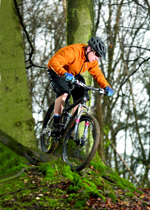 FRAME
FRAME
The front end of the Five Spot is very similar to last year’s bike. Oversized, round-profile tubes converge as the one-piece bottom bracket/shock mount/main pivot assembly. To improve tyre clearance on full compression the front mech cable stop had been placed off-centre on the seat tube. On the rear, Turner has introduced oversized asymmetric, box-section chainstays where the left-hand stay runs straight from the main pivot to the dropout. On the drive side the chainstay yoke drops down to offer enough clearance for the front mech when the suspension compresses. Dropouts are now fluted and the rocker plates are a trellis-forged design for improved stiffness.This is the only frame on test not to have cartridge-bearing pivots. Instead Turner uses its own bushings. They are ultra-reliable and each pivot has its own Zerk grease port so you can easily keep everything running smoothly. Stiction is non-existent and all frames come with an anodised finish.
SUSPENSION
Due to licensing issues Turner made the switch from four-bar to faux-bar for 2006 and has never looked back. Travel on the Five Spot has been increased to 5.5in, and the action of the rear suspension is noticeably less progressive than on previous Turner frames. This makes it easier to get full travel, while Fox seems to have improved the range of rebound adjustment on the new RP23 shocks.
SIZING
At 13.75in the Turner has the highest bottom bracket on test. It also has one of the shortest head tubes, so we had to have the stem quite high to maintain the same handlebar/pedal height relationship as the other bikes on test. Basically the higher bottom bracket means that you have to run the saddle higher to achieve the same leg extension. This places the rider’s centre of gravity higher above the axles and — given that the Turner has the shortest wheelbase on test — in theory, it shouldn’t be as stable as the other bikes.
PERFORMANCE
Because of the high bottom bracket, shorter wheelbase and relatively tight back end, the front end of the Turner pops easily to manual over a log or through a rut. It also tends to lift more readily when climbing and you really have to bend your arms and get your weight forward to keep the nose down on steep ascents. Point the Turner downhill and we found we had to keep our arms and legs bent and squat down to get a lower centre of gravity for improved stability, otherwise it feels like your weight is pitched too far forward.
But the high bottom bracket is not all bad, and combined with the incredibly active rear suspension it allows you to sit down and pedal through rough terrain. Also, if you run a ride-height-adjustable fork you can drop the nose of the bike for climbing without having to worry about clipping your pedals on every root and rock. The problems start if you decide that you want to lower the BB height — you’ve got nowhere to go as you won’t want to run anything skinnier than the 2.1in Maxxis Crossmark tyres we used.
VERDICT
Before we took the bikes to Afan we had the Turner and the Ellsworth pretty evenly matched for XC performance; where the Ellsworth is lighter, the Turner is stiffer. After a couple of back-to-back runs down the Skyline descent we found that while the bikes shared similar angles, the Ellsworth felt much more confident at speed, even with the noticeable frame.
MBR RATING: 8/10



